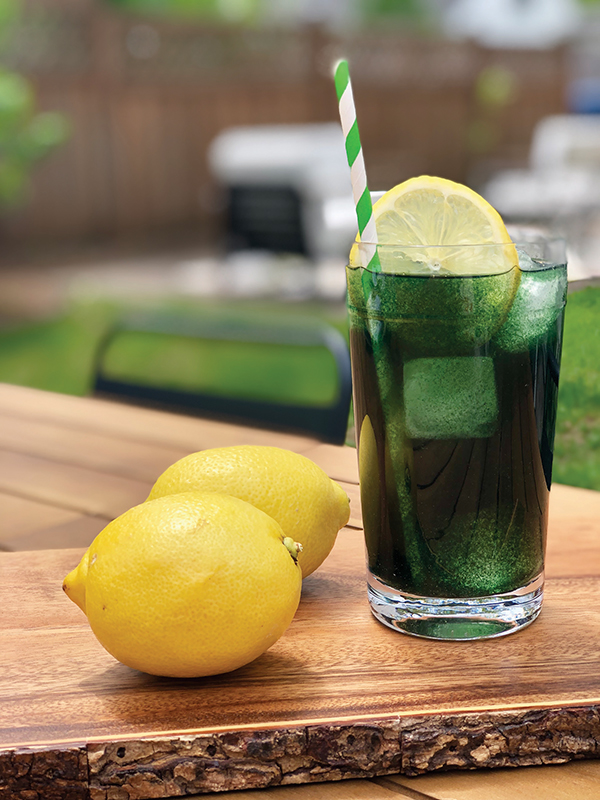HEALTHY LIVING
Mandy Moore’s mindful tips for a well-balanced, lively summer

(Family Features) With plans of trips and relaxation on the horizon, it can be easy to give your wellness routine a vacation, too. Before you jet set off on your next adventure, take a moment to be consciously aware of how your mind and body may react to an overly active and jam-packed summer schedule.
“As someone with a busy lifestyle, having an intentional, balanced wellness routine helps me be my best self for my job, my friends and my family,” said actress and wellness advocate Mandy Moore.
Partnering with Nature’s Way to celebrate its 50th birthday, Moore shares a passion for paving a better way to wellness. While no single trick or technique guarantees well-rounded health, it’s really about establishing habits that work best for you and your lifestyle. Your routine may often change daily depending where you are on your wellness journey, but Moore shares thoughtful considerations to always keep in mind:
1. Start from Within. It’s important to understand the connection between your mind and body.
“I recognize it takes time, trust and baby steps, but the outcome is incredibly rewarding,” Moore said. “I’m a strong believer in the power of therapy and find my most important work is done during the moments when I feel like I’m operating at 100 percent.”
She also recommends downloading a meditation app, calling a friend or writing in a journal to help balance a hectic summer schedule.
2. Seek New Ways to Nourish Your Body. Wellness goes beyond simply what you put on your plate. Listening to your body can help you go the extra mile, especially when you’re traveling, which is why Moore takes Alive! Women’s Energy from Nature’s Way, packed with 16 different health-benefiting vitamins and minerals.
Drinking water-based beverages is a big piece of her wellness routine, as well. She loves relaxing with tea sourced from around the globe and drinking water with liquid chlorophyll for an internal refresher.
3. Breathe in the Sights, Scents and Sounds of Nature. In today’s fast-paced world, it’s important to take time to breathe; to take in nature’s true beauty. Watch a sunset, walk through a park or get away from the city lights so you can really see the stars shine. Be more proactive this summer and immerse yourself in environments that truly allow you to feel renewed.
Moore loves to go hiking and walks her dogs, Jackson and Joni, each day.
“There’s something that’s innately healing about feeling connected to the ground – feeling grounded, literally, to the world around you,” Moore said.
4. Unplug to Recharge. Even if your schedule constantly keeps you on the go, it’s important for your mental health and well-being to take time to unplug and find different ways to clear your mind.
“Take moments to step away from the computer, tablet or phone – put it in the other room, let it charge and do something else constructive for your brain,” Moore said. “Pick up a book, put on an album, call a friend, light a candle and decompress. I’m a big proponent of smell; sense therapy is really helpful for me. One of the first things I do when I get home is light a candle.”

Summer Travel Advice
According to an AAA Travel survey, nearly 100 million Americans – 4 in 10 U.S. adults – are planning to take a family vacation in 2019, slightly more than last year, with road trips topping many vacationers’ plans. Before you depart from reality, take a moment to ensure you and your loved ones are fully prepared with these tips.
Pack Your Patience
Be prepared for busy roads and long airport security lines throughout the summer. Bring books, games or music for the ride to keep kids and other passengers entertained. Pack healthy snacks for kids, especially if you can’t fit in a full meal while traveling, and don’t forget to pack a pillow as well as information on your destination.
Take Preventative Measures
Air travel, especially on international flights, can be stressful and lead to extra strain on your physical and psychological health. Fatigue, increased stress and mental changes have also been reported during and after long-distance flights, according to the U.S. National Library of Medicine. Take time to make sure your immune system is functioning at its best.
A study published in “Nutrients,” found air travelers taking capsules containing elderberry extract before and during their trips experienced an improved immune system response versus travelers who were given a placebo.
Elderberry extract is available in a variety of travel-friendly formats. For example, Nature’s Way, a pioneer in the health industry, offers Sambucus Elderberry Zinc Lozenges and Gummies, which can be found at most health and wellness retailers. Be sure to ask your health care provider for advice when adding a new supplement to your diet.
Break a (Free) Sweat
These days, many hotels and resorts offer on-site fitness rooms, but they may not always have your preferred equipment and machinery. If you decide to hit the gym, you may be able to score a free day pass. A lot of chain gyms, and even some local operations, may offer free, one-day trial experiences. With a little research in advance of your trip, you can ensure your fitness routine doesn’t go out the window simply because you’re away from home.

For more ways to take care of your body and mind this summer, visit 50.naturesway.com.
Cool Off with Chlorofresh
Servings: 1
- 8 ounces lemon water
- 1 squeeze fresh lemon juice
- 1/2 teaspoon ground ginger
- 1 pinch salt
- 1 teaspoon Nature’s Way Chlorofresh Liquid Chlorophyll (unflavored)
- Mix lemon water, lemon juice, ground ginger, salt and unflavored chlorophyll liquid. Serve over ice.
Photo courtesy of Getty Images (woman looking out to sea)
SOURCE:
Nature’s Way
HEALTHY LIVING
4 things parents, youth athletes should know about concussions

(Family Features) Despite the attention drawn to the topic of concussions over the past decade, it can be difficult to find readily available answers about what parents and young athletes should do after sustaining a concussion.
The Katsuyama family started 2023 without a single concussion, even with quite a few hockey and lacrosse seasons under its belt. That changed when Rylan, 11, received two concussions within five months from sports. One week after Rylan’s second concussion, his brother, Brandon, 13, was illegally checked from behind in a hockey game and sustained his first concussion. After clearing protocol in four weeks, he suffered a second concussion six weeks later.
Both boys endured months of headaches, missed school, dizziness, nausea and the added difficulty of navigating a significant injury peers and adults couldn’t see.
Their father, Brad Katsuyama, co-founder of IEX – a disruptive stock exchange featured in the best-selling book by Michael Lewis, “Flash Boys: A Wall Street Revolt” – sought out expert opinions to guide his family’s decisions and shares some acquired knowledge to help parents and athletes.
1. Brain injuries should be diagnosed by a concussion specialist.
There is no X-ray, MRI or CT scan that can show the extent of most concussion-related injuries, which makes diagnosing them subjective. Symptoms can also appear days after a hit. For example, Brandon was cleared by the emergency room after his first concussion, but two days later failed every test administered by a doctor specializing in concussions.
2. Rushing back to play is one of the worst mistakes you can make.
Experts consistently reinforced that coming back from a concussion too soon can significantly increase long-term brain injury risks. There is likely no tournament, playoff game or tryout worth this risk. An example of how to return smartly is Patrice Bergeron of the National Hockey League’s Boston Bruins, who sat out an entire year to properly heal from a concussion.
“Patrice had four more concussions over his career, and each one was less severe than the last,” renowned concussion specialist Dr. Robert Cantu said. “That wouldn’t have happened without recovery from the first one.”
3. Parents and kids need to be honest about symptoms.
The culture in youth sports praises toughness. Getting your “bell rung” and continuing to play can be viewed as a badge of honor. However, this same mentality can cause athletes to lie to parents, trainers and coaches to get back in the game, which can greatly increase long-term risks. Conversely, the same adults can unduly influence a potentially vulnerable player back on to the field of play. Proper diagnosis requires both adults and athletes to be level-headed and honest in their assessment of concussions.
4. Every person and every concussion is different.
One person’s history and experience with concussions seldom carries any relevance to the concussions experienced by another. For example, Katsuyama played varsity football, hockey and rugby for four years in high school and football in college.
“For the longest time, my definition of a ‘real’ concussion was blacking out, vomiting or pupils dilating,” Katsuyama said. “My sons had none of those symptoms after their hits, but it turns out the severity of their injuries were far greater than anything I had experienced.”
The Katsuyamas turned to the Concussion Legacy Foundation and the Cantu Concussion Center, in addition to their local concussion specialist, to advise their path forward, which has led them to racquet sports and golf in the near-term and long-term playing no more than one contact sport in a school year. Learn more at concussionfoundation.org.
Photo courtesy of Shutterstock
SOURCE:
Brad Katsuyama
HEALTHY LIVING
Getting high cholesterol under control

(Family Features) Heart disease is the nation’s leading cause of death for men and women, according to the Centers for Disease Control and Prevention, but many people aren’t aware they may be at elevated risk. More than 71 million adults in the United States have high low-density lipoprotein (LDL) cholesterol and nearly 50 million don’t have it under control, which puts them at higher risk for cardiovascular events, such as heart attack and stroke.
What’s more, nearly one-third (31%) of U.S. adults are not aware that having high cholesterol puts them at greater risk for heart attack and stroke, according to the findings of a recent study conducted by The Harris Poll commissioned by Esperion Therapeutics, Inc. The poll also revealed some inconsistent understanding about treatment options available for those with uncontrolled cholesterol. Fully 3 in 10 (30%) of those taking statins believe statins are the only LDL lowering treatment available for those with high LDL cholesterol.
“In auto racing, the red flag means danger on the track, stopping the race immediately,” said Dr. JoAnne Foody, chief medical officer at Esperion. “We are launching a patient education program, ‘Wave the Red Flag,’ to encourage people with uncontrolled high cholesterol to have their levels checked right away and discuss appropriate treatment options with their health care provider.”
If your high cholesterol is uncontrolled, understanding how you can achieve greater control can reduce your risk for serious health conditions, including potentially life-threatening cardiovascular events.
Consider these tips to get high cholesterol under control.
Talk with your doctor. Speaking with your physician is an important first step to managing any health condition. Your doctor can help you understand the severity of your condition and whether a treatment plan should be moderate or aggressive.
Check your progress. Keeping tabs on your cholesterol can help you and your health care team gauge whether your treatment plan is working. If you don’t have heart disease, you may not need to check as frequently, but your doctor can recommend the appropriate intervals to help manage your cholesterol most effectively.
Take medications as prescribed. Statins are the medications most often recommended by treatment guidelines for the management of blood cholesterol, and nearly one-third (30%) of those taking statins believe they are the only cholesterol-lowering treatment available, according to the survey. However, even with maximal statin therapy, some patients with chronic disease do not meet recommended LDL cholesterol levels. Taking your medications regularly and as instructed helps your doctor determine whether additional therapies – including non-statin treatments – could be useful to help manage your blood cholesterol.
Make lifestyle adjustments. Your diet plays a major role in lowering LDL cholesterol. Limiting fatty foods, especially those that are high in saturated and trans fats, is key. Monitoring your overall diet and exercising can also help reduce your risk of high cholesterol. Even if you don’t have high cholesterol, adopting more cholesterol-friendly habits can help prevent your levels from rising to unhealthy levels in the future.
To find additional information about managing your high cholesterol, talk to your health care provider and visit WaveTheRedFlag.info.
Fast Facts About Cholesterol
What is cholesterol?
The liver creates a fat-like waxy substance called cholesterol. It serves useful purposes for the body, including producing hormones and helping digest food.
How do you get high cholesterol?
The human body makes all the cholesterol it needs naturally, so any cholesterol you eat is cholesterol you don’t need. However, it can be difficult to avoid because you can find dietary cholesterol in many common foods, including meat, seafood, poultry, eggs and dairy. Other non-dietary contributing factors include health conditions like obesity and diabetes, as well as family history and advancing age.
What is a normal cholesterol level?
An average optimal level of LDL cholesterol is about 100 milligrams per deciliter (mg/dL).
An average optimal level of high-density lipoprotein, or HDL, cholesterol is at least 40 mg/dL for men and 50 mg/dL for women. HDL cholesterol can actually lower your risk of heart disease and stroke.
Are there symptoms of high cholesterol?
Unlike many health conditions, there are rarely any symptoms that your cholesterol is high. That’s what makes regular screening so important.
Photos courtesy of Shutterstock
SOURCE:
Esperion
HEALTHY LIVING
Learn CPR as a life-saving skill

(Family Features) While many Americans agree Conventional CPR (cardiopulmonary resuscitation) or Hands-Only CPR (HOCPR) significantly improve a person’s chance of survival from cardiac arrest, less than half are confident they can perform either Conventional CPR or HOCPR in an emergency.
Black or Hispanic adults who experience cardiac arrest outside a hospital setting are substantially less likely to receive lifesaving care from a bystander. In spite of these survey results, the American Heart Association is working to change this by empowering members of these communities to learn lifesaving CPR, and a growing segment of respondents are willing to act in an emergency.
The American Heart Association’s 2023 survey also revealed that as a result of the organization’s efforts to change attitudes about performing CPR, which can lead to lifesaving results, more than half of African Americans said they would be willing to perform CPR in an emergency compared to 37% two years ago. Additionally, Hispanic and Latino respondents are more confident in their abilities to perform CPR.
Committed to turning a nation of bystanders into lifesavers, the American Heart Association’s multiyear initiative, Nation of Lifesavers, helps teens and adults learn how to perform CPR and use an automated external defibrillator (AED); share that knowledge with friends and family; and engage employers, policymakers, philanthropists and others to create support for a nation of lifesavers.
“Each of us has the power in our own hands to respond to a sudden cardiac arrest,” said Anezi Uzendu, M.D., American Heart Association expert volunteer. “We simply need to know what to do and have the confidence to act.”
The long-term goal: to ensure that in the face of a cardiac emergency, anyone, anywhere is prepared and empowered to perform CPR and become a vital link in the chain of survival, aiming to double the survival rate of cardiac arrest victims by 2030. It takes just 90 seconds to learn how to save a life using HOCPR, which can be equally as effective as traditional CPR in the first few minutes of cardiac arrest.
Nationally supported by the Elevance Health Foundation, the American Heart Association’s HOCPR campaign is focused on chest compression-only CPR. If a teen or adult suddenly collapses due to a cardiac event, you can take two steps to save a life: immediately call emergency services and use these tips to begin performing HOCPR.
- Position yourself directly over the victim.
- Put the heel of one hand in the center of the chest and put your other hand on top of the first.
- Push hard and fast in the center of the chest at a rate of 100-120 beats per minute, which is about the same tempo as the song “Stayin’ Alive” by the Bee Gees, and at a depth of approximately 2 inches.
- Continue compressions and use an AED, if available, until emergency help arrives.
To learn more about how you could be the difference between life and death for someone experiencing a cardiac event, visit Heart.org/nation.
Photo courtesy of Shutterstock
SOURCE:
American Heart Association
-

 NEWS1 year ago
NEWS1 year ago2 hurt, 1 jailed after shooting incident north of Nocona
-

 NEWS5 months ago
NEWS5 months agoSuspect indicted, jailed in Tia Hutson murder
-

 NEWS1 year ago
NEWS1 year agoSO investigating possible murder/suicide
-

 NEWS1 year ago
NEWS1 year agoWreck takes the life of BHS teen, 16
-

 NEWS9 months ago
NEWS9 months agoMurder unsolved – 1 year later Tia Hutson’s family angry, frustrated with no arrest
-

 NEWS12 months ago
NEWS12 months agoSheriff’s office called out to infant’s death
-

 NEWS1 year ago
NEWS1 year agoBowie Police face three-hour standoff after possible domestic fight
-

 NEWS1 year ago
NEWS1 year agoDriver stopped by a man running into the street, robbed at knifepoint





